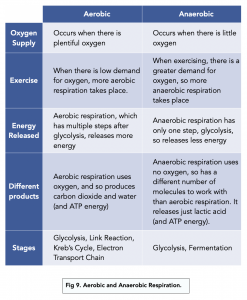Anaerobic Respiration (A-level Biology)
Anaerobic Respiration
Anaerobic Respiration
The Process of Anaerobic Respiration

- Anaerobic respiration occurs in the absence of oxygen. The body also has a mechanism to continue producing small amounts of energy without oxygen. This is called anaerobic respiration.
- Anaerobic respiration converts glucose into lactic acid. Lactic acid, rather than water and carbon dioxide, is made in anaerobic respiration in muscles. Remember anaerobic respiration occurs without oxygen, so we do not include oxygen in the equation. We have only used glucose and produced lactic acid.
- Anaerobic respiration transfers less energy than aerobic respiration. Anaerobic respiration is less efficient than aerobic respiration, as not all of the glucose can be broken down. This means less energy can be transferred.
- Anaerobic respiration involves 2 steps. Anaerobic respiration is a two-step mechanism which involves only glycolysis and fermentation. We will explore these in the next chapter.
ATP Yield of Anaerobic Respiration
- Anaerobic respiration is inefficient. The amount of ATP produced from a single molecule of glucose is very little as compared to aerobic respiration. Anaerobic respiration is sufficient to support the life processes of simple organisms such as prokaryotes. Anaerobic respiration is insufficient and incapable of supporting life processes in complex, multicellular eukaryotic organisms for more than a short time.

Anaerobic respiration is a type of cellular respiration that takes place in the absence of oxygen. It is a metabolic process that occurs in cells and produces energy in the form of ATP (adenosine triphosphate) from the breakdown of glucose.
Aerobic respiration requires the presence of oxygen, while anaerobic respiration does not. Aerobic respiration produces a larger amount of ATP compared to anaerobic respiration and is therefore more efficient. Aerobic respiration also produces carbon dioxide and water as waste products, while anaerobic respiration produces lactic acid or alcohol and carbon dioxide.
There are two types of anaerobic respiration: lactic acid fermentation and alcoholic fermentation. Lactic acid fermentation occurs in the muscles and produces lactic acid, which can cause muscle fatigue. Alcoholic fermentation occurs in yeast and other microorganisms and produces alcohol and carbon dioxide.
Lactic acid fermentation is a metabolic process that takes place in the absence of oxygen and produces lactic acid from the breakdown of glucose. The process starts with the conversion of glucose into pyruvate, followed by the conversion of pyruvate into lactic acid. This process releases energy in the form of ATP, which can be used by the cells.
Alcoholic fermentation is a metabolic process that takes place in yeast and other microorganisms and produces alcohol and carbon dioxide. The process starts with the conversion of glucose into pyruvate, followed by the conversion of pyruvate into acetaldehyde and carbon dioxide. The acetaldehyde is then converted into ethanol. This process releases energy in the form of ATP, which can be used by the cells.
Anaerobic respiration has several applications, including the production of food and beverages, such as bread, beer, and wine. It is also used in the production of biofuels, such as ethanol, and in the treatment of wastewater, as anaerobic bacteria can break down organic matter in the absence of oxygen. Additionally, anaerobic respiration plays a role in the generation of energy in the muscles during intense exercise, as well as in the process of decay in dead organic matter.






Still got a question? Leave a comment
Leave a comment